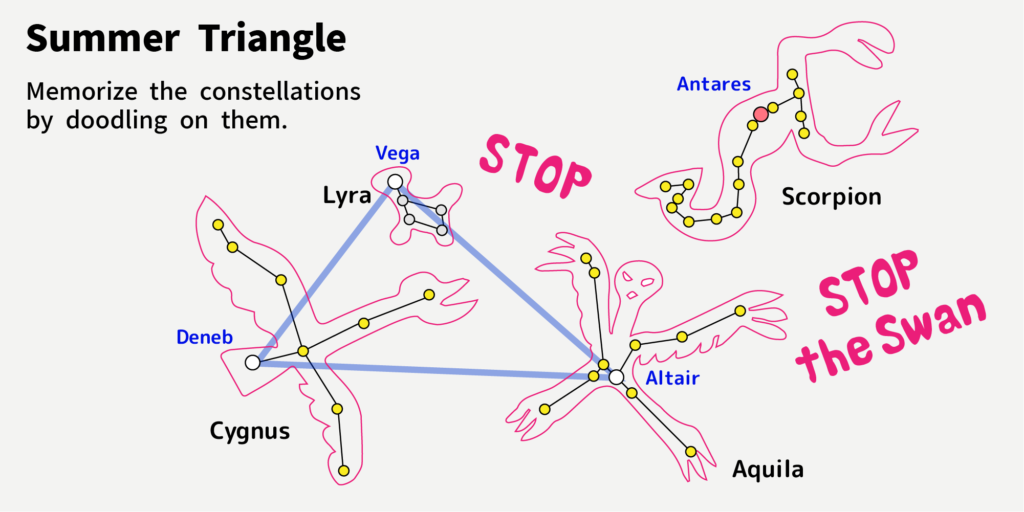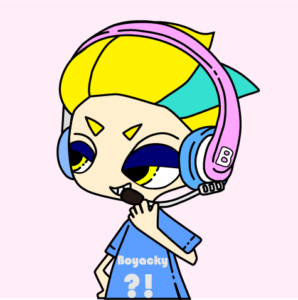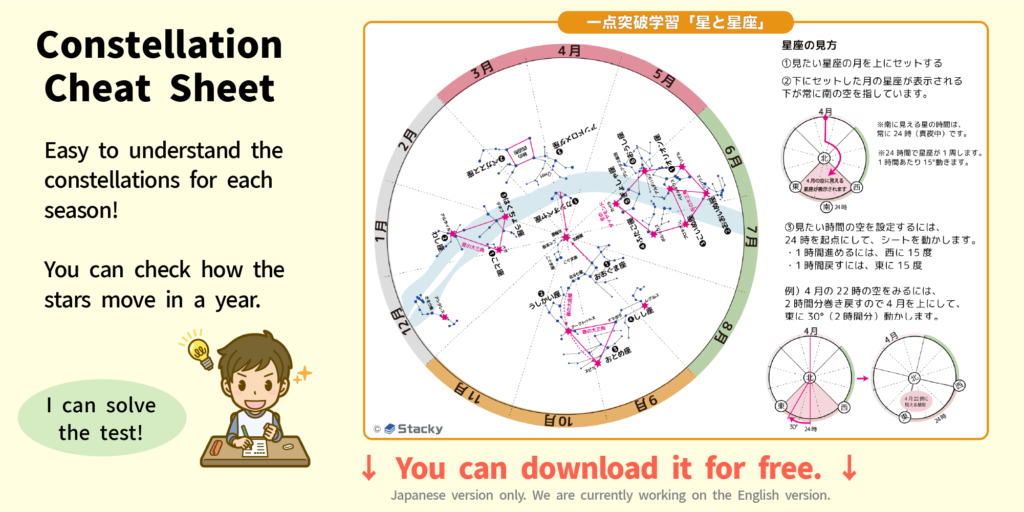
Hi Everyone, I am Stacky!
When you study, most of you have experienced the feeling of “I am not good with this subject, topic or specific formula.”
In my house, the subject of Constellations was one of those topics.
However if the subject we are not good at appears to be frequently questioned in exams etc., I think to myself “Why not we just get rid of the ‘I am not good’ feeling and become experts!”
Today, I want to share One Subject Focused Study method on the topic of stars and constellations.
This article would help those people like…
・Your kid is clearly saying “I am not good / do not like topic of Stars and Constellations”.
・The tool, “Quick look up Constellation”, is sitting on your bookshelf and has never been touched.
・People who think “There is one universe, why are we seeing different figures every season?”
・Those who truly believe there are gods in milky sky and love Greek Mythology!
Here we share our tips for you to build your strength around the topic of stars and constellations.
Let’s study!
Why did the Constellations became my “I am not good with…” topic?
I do not understand why constellations apear on exams?!
Science exams frequently test our knowledge of constellations.
However, our text books do not even explain why stars and constellations are important.
Meanwhile, kids living in cities and not used to looking up at the sky at night do not find much interest in constellations if they are just introduced to our universe with boring diagrams and sentences.
Also, stars at least do exist in real life. Constellations however, do not. This can make kids think ”Why are we trying to remember these made-up images of stars?”
Text books confuses me with understanding constellations.
Without reaching to the level of understanding seasonal constellations, when there are questions about details like brightness or colour of stars, kids feel just lost.
How constellations look will vary not only by season, but also by timing and locations. Without this understanding, questions confuse kids more than it interests them.
Kids without basic understanding of stars and constellations would of course feel “I am not good at this” and would dislike the topic when facing these complicated questions.
We need to end this “I am not good at…” feeling for stars and constellations!!
Understand Constellations with Simple logic
Change your view of constellations
First, we need to study how constellations were originally formed.
In ancient times, without having maps, people used Polaris as the marker towards North.
For humans to communicate with each about stars, the concept of constellations fit well to help effectively explain them.
Therefore, the constellations was the conceptual tool to find stars around the base line star Polaris.
Furthermore, seasonal movements of stars were indicators of time for planning and harvesting crops. And the Portuguese used Celestial navigation on the oceans to naviagate and guide their ships.
Just as we do today, many years ago people tried to avoid having their crops wiped out by floods, and tried to avoid losing direction on the ocean in the dark.
[Feel the wisdom of ancestors!] Are you starting to feel a little motivation for studying constellations?
Understand the logic of ancestors as they acquired knowledge around constellations
Now draw those seasonal major constellations and make your own story looking at them.
As an activity explain to your family the constellations you have drawn.
Tip – Let’s draw those constellations near Polaris that do not move much.

Starting to remember constellations of Summer?
 Boyacky
Boyacky The Hawk is trying to stop the Swan targeting a Scopio going along the Harp right?
And the summer triangle is Deneb at the tail of the Swan, Altair the belly of the Hawk and Vega is the right handle of the Harp.
Very quickly, positions of stars in the constellations with colour and brightness remembered!
Very Good! Lol
Well, through this activity, we laughed that our drawings were not as good as hoped… came up with “Stop the Swan” motto?! … etc. wonderful moments!
Look at the bigger picture of the universe, turning your image of the universe around.
I get just confused if those seasonal constellation figures were just provided and explained…
And you will not have those quick look up tools at the exam so we have to have those images of figures only in our brains…
So we created a “Constellation Cheat Sheet” covering all the universe in one sheet.
This sheet has less information of stars than the quick look up tool and it is without the restricted view from wherever we are on the earth.

This sheet is created focused on the basic movements of the stars.
Where applicable, you can add Zodiac information.
Run the Q&A with constellation night tour.
This activity is to put your memory of dots into figures by communicating around real stars.
We run the Constellation night tour with a smart-phone application called “Star Walk 2”.

Which stars do you see and where are they?
 Boyacky
Boyacky Hmm… it’s May now so the Big triangle of Spring should be seen in the southern sky at around midnight. And now it is 4 hours to midnight so turn around 60 degrees, ohhhh I see it!
So that is the Altaris which means the Big Dipper … ohhh the Big Bear, just there clearly!
Through the night tour, we could see and feel the brightness of first-class stars.
Walking through the night tour in different seasons, and at various times, you acquire great knowledge of constellations as well as good health!
The only weakness of this night tour is the Japanese rainy season…
Extend your study through virtual images
Run the constellation night tour during the day time under all weather conditions.
Exploring Boyaky’s budding newfound interest in constellations, I want to go see constellations under practically any weather conditions…
the “Homestar VR” was found!
You can see all the shining stars like a planetarium with virtual reality (VR) goggles.

This is what allows you run the night tour at home under all weather conditions.
It was our first experience in using VR technology but I felt it will become a more and more necessary tool through our studies.
What do you think of Homestar VR?
 Boyacky
Boyacky We can even see those stars that are dark and difficult to find in the real sky. And it corrected some of my images of constellations. The Twins were facing to each other. Lol.
And it allows us to see stars you can only see in the Southen Hemisphere. Let’s go see more in our next lunch time break!
Seeing Boyacky’s newfound interest in stars, I realize it really was worth it spending 3 hours on this tour.
As you start to understand, you realize your self interest in Planetariums.
By searching for stars and constellations, you get led to famous Observatories and Planetariums.
Those I found interesting were “Manten”, “Tenku” and “Planetaria Tokyo” produced by Konika-Minolta.
I saw the comments of those who experienced wonderful feelings of healing and relaxing! It was very interesting.
Why we were taken to those planetariums in our childhood… let’s not talk about it now!
Summary
How was our method of One Subject Focused Study on Stars and Constellations?
Focusing on one single subject for half a day, it will motivate you to get more interested in the subject.
- Focused 3-4 hours of study on one subject – Stars and Constellations has enabled you to answer many of exam-type questions.
- Building your basic knowledge of stars and constellations, your motivation to know more will spike up and you will naturally learn more.
- Memories with figures, and stories with others, are easier to remember.
Feeling of “I am not good…” makes you stay away from these subjects/topics.
Given a little more complicated questions, if you have basic understanding you may feel like these complicated questions are actually interesting rather than torture.
When you see someone hesitating to learn a specific topic, it may worth trying our One Subject Focused Study method.
